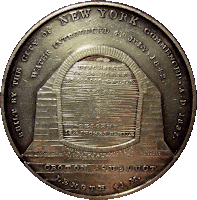1842 Croton Aqueduct Completion Medals
Begun in 1837 and completed in 1842,
the Croton Reservoir and Aqueduct and it's distribution system in the
city of New York was the largest engineering project in this country at
the time. Robert Lovett Sr. was commisioned to produce medals to be
awarded at the celebration held on October 14th, 1842. Engraved silver
medals were struck to be presented to the 17 Alderman as well as other
dignitaries. How many of these were produced I have yet to determine.
Bronze and white metal versions were also produced and again I do not
have any information on the number struck. All are fairly scarce.
The medals are approximately 51mm in
diameter with the bronze version being thicker than the silver and
white metal. One face shows a cutaway of a portion of the aqueduct with
statistics about the size and flow rate. The other face depicts the
Murray Hill Distributing Reservoir with a city scene in the background
and facts about the capacity of the system below. This Distributing
Reservoir sat on the site of what is now the New York City Public
Library. They are beautiful examples of the engraver's art.
Silver, Awarded to "General Hopkins, Grand Marshall", 51mm
|
|
|
|
Receipt for payment on water bill, May 19, 1869
Bronze, 51.2mm
(ex. John j. Ford Jr. Collection)
|
|
|
|
July 22, 1842 letter to 'Brother Henry'
A line in this letter tells of a fire and reads "The abundant
supply of the Maid of Croton Water prevented a large fire, which
in old times could not have been prevented for want of water"
Silver, Awarded to "George P. Morris, Author of the Croton Ode", 51mm
|
|
|
|
George P. Morris was also presented with a silver medal from the
Baltimore female College, engraved by Robert Lovett Jr.. How many people
can claim to have medals from both father and son? See the Baltimore
Female College page to see this medal.
Silver, awarded to "John Stewart, Ald. 14th Ward, 1842" in
original case, 51.1mm
|
Currently I know of the existence of 7 silver engraved examples. One example, to "Stephen Allen / 1st Prest Comrs." in
the original case, is in the collection of the New York Historical
Society. Two others, to "R.F. Carmane/Ald. 12th
Ward" and "J.B. or I.B. Scoles 1st Ald., 14th Ward" are in private numismatic collections. Another example awarded to "H.W. Bonnell/Ald 13th Ward" is still in the possession of a great, great grandaughter. If anyone knows
of any others please contact me.
|
These
silk ribbons celebrating the opening of the Croton Aqueduct have the
same text but were issued by different entities. The example on the top
was issued by a merchant at No. 1 Courtland Street, the same address on
John D. Lovett's Store Cards.
|
Bronze Medal in original case of issue
 |
| (image courtesy of Robert Kornfeld) |
|
White Metal, 51.2mm
|
|
|
|
White Metal, wreath reverse, 51mm
IMAGE NEEDED
A Presidential
Coin and Antique Auction in 1995 contained a white metal version of this
medal with a reverse described
as "a narrow wreath around the border with a large
empty center indicating it was meant for later engraving. The use of
which this medal was
intended is open to speculation - its rarity is
not!". Was this struck by Robert Sr. or did someone at a later date
remove the reverse design and strike this new one?
Anyone with information on this please contact me. Sterling silver medal presented to Brian Goodman These images and information on Brian Goodman were provided by his son, Alistair Goodman. Brian was the first Site Manager for the Old Croton Aqueduct State Historic Park until his retirement in 2002 when he was presented this medal.
|
Silver - 96.78%, traces of copper and zinc, uninscribed, 51mm
|
|
|
|
Is this a trial strike of
some sort, possible a poorly struck piece that was never inscribed? The
flaws seem to be part of the planchett.
|
Letter to Chief Engineer Jervis dated 1839
Cast copy of Croton Aqueduct Completion Medal, 51mm
|
|
|
|
Bronzed white metal, 51mm
| I have only seen two examples of these bronzed pieces and both were heavily scratched. |
"Pay List for Cartage of Pipes" 1847
81.7% tin, 14.2%copper, 3.5% silver.5% iodine, 51.2mm
Not sure exactly what to call this composition? The weight and thickness are close to that of the white metal example. Someone attempting to plate a white metal example?
|
Robert Ready's British Museum Replica, copper-plated lead, 50.6mm
The British Museum hired sealmaker Robert Ready in 1859 to produce
electrotypes of coins, medal and seals in their collection.






























